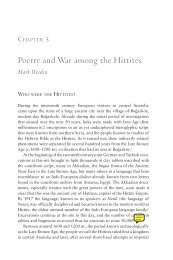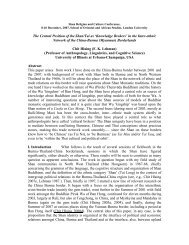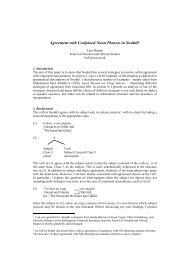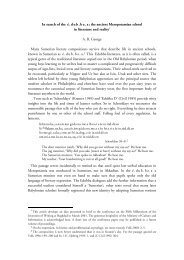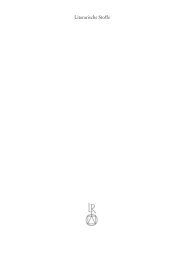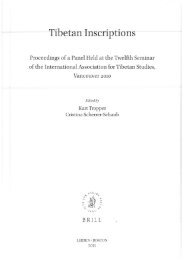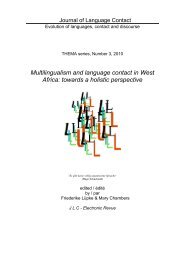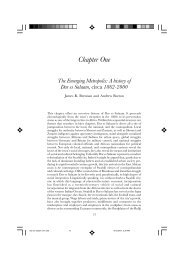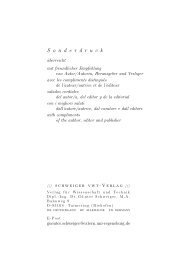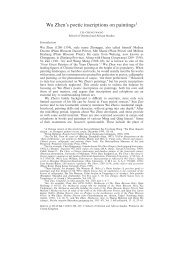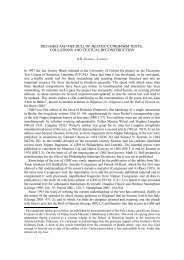Download (1016Kb) - SOAS Research Online - The School of ...
Download (1016Kb) - SOAS Research Online - The School of ...
Download (1016Kb) - SOAS Research Online - The School of ...
Create successful ePaper yourself
Turn your PDF publications into a flip-book with our unique Google optimized e-Paper software.
Bulletin <strong>of</strong> the <strong>School</strong> <strong>of</strong> Oriental<br />
and African Studies<br />
http://journals.cambridge.org/BSO<br />
Additional services for Bulletin <strong>of</strong> the <strong>School</strong> <strong>of</strong><br />
Oriental and African Studies:<br />
Email alerts: Click here<br />
Subscriptions: Click here<br />
Commercial reprints: Click here<br />
Terms <strong>of</strong> use : Click here<br />
Tibetan gseb and Cognate Words<br />
Walter Simon<br />
Bulletin <strong>of</strong> the <strong>School</strong> <strong>of</strong> Oriental and African Studies / Volume 20 / February 1957, pp 523 <br />
532<br />
DOI: 10.1017/S0041977X00062078, Published online: 24 December 2009<br />
Link to this article: http://journals.cambridge.org/abstract_S0041977X00062078<br />
How to cite this article:<br />
Walter Simon (1957). Tibetan gseb and Cognate Words. Bulletin <strong>of</strong> the <strong>School</strong> <strong>of</strong><br />
Oriental and African Studies, 20, pp 523532 doi:10.1017/S0041977X00062078<br />
Request Permissions : Click here<br />
<strong>Download</strong>ed from http://journals.cambridge.org/BSO, IP address: 212.219.238.14 on 15 Oct 2012
TIBETAN GSEB AND COGNATE WORDS<br />
By WALTER SIMON<br />
I<br />
THE entry gseb in Jaschke's Tibetan dictionary, 1 which has been taken over<br />
almost without a change into that compiled by Sarat Chandra Das, 2<br />
poses a problem in so far as it differs in an important point from the entries<br />
to be found in the dictionaries <strong>of</strong> A. Csoma de Koros, 3 I. J. Schmidt, 4 and that<br />
<strong>of</strong> the Catholic Missionaries <strong>of</strong> Tibet, generally referred to as Desgodins'<br />
dictionary. 5 While all these dictionaries are in agreement on the meaning <strong>of</strong><br />
' stallion ', which has been listed by J(aschke) under I, the difference occurs in<br />
the treatment oigseb (alternating with seb), listed by J under II. <strong>The</strong> definitions<br />
are as follows :<br />
(i) Csoma:<br />
(a) (p. 296)<br />
!• s. assemblage, crowd, crew ; heap, pile, rick, stack<br />
khrod J<br />
seb lam 1 ,<br />
\ a short cut, a secret way or road<br />
gsan lam J<br />
(b) (p. 38)<br />
gseb a heap, pile, crowd, assemblage<br />
(ii) Schmidt:<br />
(a) (p. 596)<br />
seb oder Jehrod Menge, Gedrange, ein Haufe, eine Ansammlung;<br />
ein Stoss, Schober<br />
seb lam ein kurzer Strich, ein heimlicher Weg<br />
gsan lam idem<br />
(b) (p. 612)<br />
gseb ein Haufen, eine Ansammlung etc. ; s. seb<br />
(iii) Desgodins 6 :<br />
(a) (p. 1023)<br />
seb, gseb = khrod rassemblement, reunion<br />
gseb lam = gsan lam carrefour, route secrete<br />
(6) (p. 1049)<br />
gseb, seb troupe, tas, rassemblement<br />
hkhrigs gseb reunir ensemble, condenser<br />
1 H. A. Jaschke, A Tibetan-English dictionary, London, 1881 (reprinted 1934).<br />
2 Tibetan-English dictionary, Calcutta, 1902, p. 1309.<br />
3 Essay towards a dictionary, Tibetan and English, Calcutta, 1834.<br />
4 Tibetisch-deutsches Worterbuch, St. Petersburg, 1841.<br />
6 Dictionnaire thibetain-latin-francais par les Missionnaires catholiques du Thibet, Hongkong,<br />
1899.<br />
6 I have omitted the Latin definitions.
524 w. SIMON<br />
gron gseb villages dont les maisons sont contigues<br />
dmag gseb armee<br />
(iv) Jaschke (p. 590)<br />
II. also seb,<br />
1. the narrow INTERSTICES between persons or things thronged<br />
together, hence with na, tu, and la, BETWEEN, AMONG,<br />
with nas FROM BETWEEN<br />
(1 x ) khyi mihi gseb la mchoii the dog leaps into the<br />
midst <strong>of</strong> the people 2<br />
(2) lo-mahi gseb-tu hjog-pa (rGyal-rabs) to put between<br />
leaves<br />
(3) sprin-gyi gseb-nas lus phyed hthon s (rGyal-rabs)<br />
half <strong>of</strong> his body protrudes from between the<br />
clouds = rises above, etc.<br />
(4) gron-gseb-tu biugs-pa (Milaraspa) to sit among<br />
the villagers<br />
(5) Jchyed-cag-gi gseb-na Meu-dgal bya-bahi bud-med yoddam<br />
? is there a woman among you named<br />
Meu-dgal ?<br />
gseb-lam a secret path, by-way, between rocks or underwood<br />
2. multitude, crowd<br />
dmag-gseb army<br />
nags-gseb 4 forest<br />
Before elaborating the difference in the treatment <strong>of</strong> gseb by J and the<br />
other lexicographers it is necessary to realize that this difference is primarily<br />
one between Csoma and J, since Schmidt merely translated Csoma's definitions<br />
into German and Desgodins' dictionary appeared later than J's. <strong>The</strong> difference<br />
may be summarized as follows :<br />
(1) J introduces the new meaning <strong>of</strong>' narrow interstices', which he illustrates<br />
by as many as five examples.<br />
1 I have numbered the examples, adding at the same time the sources from the German<br />
edition <strong>of</strong> J's dictionary (Handworterbuch der tibetischen Sprache, Gnadau, 1871, p. 614), which<br />
have apparently dropped out in the process <strong>of</strong> preparing the English version. I take this opportunity<br />
<strong>of</strong> mentioning another omission in the English edition. On p. xxi under ' Abbreviations '<br />
add : Lt. = Lhan-thabs, a medical work, No. 475 <strong>of</strong> the ' Verzeichnis ' by [I. J.] Schmidt [and<br />
0. Bohtlingk (Bulletin de la Classe des Sciences historiques, philologiques et politiques de FAcademie<br />
Imp. des Sciences de St. Pe'tersbourg, iv, 1848, col. 117)]. See now about this work, whose full<br />
title begins with Bdud-rtsi snyin-po yan-lag brgyad-pa gsan-ba man-nag yon-tan rgyud-kyi lhanthabs,<br />
(and its Mongolian version), i.a. W. Heissig, Die Pekinger lamaistischen Blockdrucke in<br />
mongolischer Sprache, Wiesbaden, 1954, pp. 96, etc., and the notes by J. W. de Jong in his review<br />
<strong>of</strong> the latter work in T'oung Poo, XLIII, 1955, 313—4. See also J, Dictionary, p. 601, s.v. lhan-pa.<br />
2 This example, which refers to a mad dog, reoccurs s.v. mchon (p. 166) as mi-seb-la (mchon)<br />
and there is translated as ' among the people '.<br />
3 <strong>The</strong> example reoccurs s.v. sprin (p. 336).<br />
4 <strong>The</strong> compound reoccurs s.v. nags (p. 300) where it is translated as ' an intersected forest'.<br />
See also below, p. 525, n. 2.
TIBETAN OSEB AND COGNATE WORDS 525<br />
(2) J retains the meaning <strong>of</strong> ' crowd', given by Csoma, but omits the<br />
meanings <strong>of</strong> ' assemblage, heap, pile, rick, stack '.<br />
(3) J retains the example gseb-lam with the interesting addition ' between<br />
rocks or underwood'.<br />
(4) J ignores the existence <strong>of</strong> the synonymous hhrod.<br />
(5) In introducing his new meaning, J is apparently unconcerned with<br />
the semasiological difficulty he creates when assigning to one and<br />
the same word meanings as far apart as ' small interstices' on the<br />
one hand and ' multitude, crowd ' on the other.<br />
I wish to make the following additional comments :<br />
ad (1) Our examination must start with the five examples which J adduces<br />
in support <strong>of</strong> the meaning <strong>of</strong>' small interstices '. It would appear<br />
that the meanings adduced by Csoma suffice to account for them,<br />
viz. the meaning <strong>of</strong> ' crowd ' in the case <strong>of</strong> exx. 1, 4, 1 and 5,<br />
the meaning <strong>of</strong> ' pile' in the case <strong>of</strong> ex. 2, and that <strong>of</strong><br />
' assemblage ' in the case <strong>of</strong> ex. 3.<br />
ad (2) Of the two examples which serve to illustrate the meaning <strong>of</strong><br />
' multitude, crowd ' and which were retained by J, the second<br />
(nags-gseb) must at some time have been understood by him<br />
as an example belonging to II, 1 since s.v. nags he translates this<br />
compound as ' intersected forest '. 2<br />
ad (3) <strong>The</strong> addition is interesting as it clearly underlines the meaning <strong>of</strong><br />
' (space) between'.<br />
ad (4) J defines hhrod (p. 52) as ' crowd, assemblage, mass, multitude '.<br />
Csoma (p. 16) has ' assemblage, crowd; pile, heap; rick,<br />
stack, etc.'. Among the examples adduced by J, we find nagskhrod<br />
' dense forest' (previously translated by Csoma (p. 77)<br />
as ' an assemblage <strong>of</strong> forest'), and an example (from the rGyalrabs)<br />
which is, in fact, very reminiscent <strong>of</strong> J's examples illustrating<br />
the use <strong>of</strong> gseb : dehi khrod-du lha-gcig hjog-pas ' placing the<br />
princess among their (the girls') company '. J's entry concludes<br />
with the very illuminating remark ' In Western Tibet khrodpahi<br />
3 nan-na and nan-du is the usual expression for " among " '.*<br />
Both the usage <strong>of</strong> khrod in present-day Western Tibet and the example<br />
adduced from the rGyal-rabs constitute striking parallels to the usage <strong>of</strong> gseb.<br />
<strong>The</strong>re is no doubt that they would have prevented a lexicographer <strong>of</strong> the calibre<br />
<strong>of</strong> J from introducing his new meaning if he had been aware <strong>of</strong> their existence.<br />
1 J evidently understands gron-gseb-tu as short for gron-pohi gseb-tu.<br />
2 See above, p. 524, n. 4. In the reprint <strong>of</strong> J's entry in S. C. Das' dictionary gseb-nags<br />
is translated as ' dense forest'.<br />
3 I have substituted khrod-pahi for the dialectal to-pai.<br />
4 cf. also English among from O.E. on gemang, lit. ' into a crowd '. (See, e.g., H. C. Wyld,<br />
<strong>The</strong> universal dictionary <strong>of</strong> the English language, London, 1932, p. 32.)
526 w. SIMON<br />
In fact, we may safely assume that this was not the case and that at that time<br />
J had not seen Csoma's definitions either. Evidence to this effect is provided<br />
by the entries khrod and gseb in J's lithographed Romanized Tibetan and English<br />
dictionary <strong>of</strong> 1866. 1 <strong>The</strong> entry khrod (tfiod) consists merely <strong>of</strong> the meanings<br />
' multitude, crowd ; great number '. On the other hand, the entry gseb reads<br />
as follows :<br />
seb I (g)seb the interstices between the individuals <strong>of</strong> a multitude <strong>of</strong><br />
persons or things, -lam, byway between rocks or trees;<br />
-na among, between : na (nas), from among<br />
II gseb a male horse or camel<br />
A comparison <strong>of</strong> this first draft <strong>of</strong> the entry gseb in 1866 with its final<br />
form in J's dictionary <strong>of</strong> 1881 justifies the assumption that J arrived at his<br />
meaning <strong>of</strong> ' interstices ' at an early stage <strong>of</strong> his lexicographical work, wrongly<br />
deducing it from such combinations with gseb as gseb-na ' between ' and gsebnas<br />
' from among', unaware <strong>of</strong> other usages <strong>of</strong> gseb, and independently <strong>of</strong><br />
Csoma. Consultation, at a later stage, <strong>of</strong> Csoma's dictionary induced him<br />
merely to make a short addition in both the German edition <strong>of</strong> 1871 and the<br />
English edition <strong>of</strong> 1881, where he limited himself to the meanings <strong>of</strong>' multitude,<br />
crowd ' (or, for that matter, ' Haufe, Menge ') listed under II, 2. When doing<br />
so, he was apparently also unaware <strong>of</strong> the semasiological difficulty he was<br />
thereby creating and furthermore overlooked the fact that <strong>of</strong> the two examples<br />
in the English edition, 2 viz. dmag-gseb and nags-gseb, the latter had been<br />
explained by him under nags as ' intersected forest', a definition which clearly<br />
recalls the ' interstices '. So the parallelism between gseb and khrod was bound<br />
to escape J, nor can he have been aware at that time <strong>of</strong> the dialectal usage<br />
<strong>of</strong> khrod, mentioned in the 1881 version <strong>of</strong> his dictionary.<br />
ad (5) While it is important to note the serious semasiological difficulty<br />
created by introducing the meaning <strong>of</strong> ' small interstices ', it is<br />
equally important to stress the qualification which J adds to this<br />
meaning, viz. ' between persons or things thronged together ', 3<br />
and the inference he draws therefrom, viz. ' hence with na, tu,<br />
and la between, among, with nas from between '. It is easy<br />
to see that ' the state <strong>of</strong> being close together or thronged<br />
together ' is a common characteristic <strong>of</strong> whatever constitutes<br />
' an assemblage, a crowd, a crew, a heap, a pile, a rick, a stack ',<br />
to repeat Csoma's definitions <strong>of</strong> gseb, and, as has been pointed<br />
out under ad (1), the examples adduced by J to illustrate the<br />
meanings <strong>of</strong> ' between, among' and ' from between ' can just<br />
as well be accounted for by accepting Csoma's meanings, as by<br />
proposing the meaning <strong>of</strong> ' small interstices ' postulated by J.<br />
Kyelang in British Lahoul, 1866, pp. 132 and 103.<br />
<strong>The</strong> German edition has only dmag-gseb, the meaning <strong>of</strong> which J queries : ' Heer (?) '.<br />
<strong>The</strong> italics are mine.
TIBETAN GSEB AND COGNATE WORDS 527<br />
In the light <strong>of</strong> the preceding discussion it would therefore seem justifiable<br />
to abandon this latter meaning, but before doing so we must consider the<br />
examples given by two Tibetan scholars who, evidently under the influence <strong>of</strong><br />
J, have assigned to gseb similar meanings (II). It will also be necessary to<br />
adduce a number <strong>of</strong> further examples to illustrate the usage <strong>of</strong> gseb (III).<br />
II<br />
<strong>The</strong> two meanings in question are ' space between' and ' narrow interspace<br />
'. <strong>The</strong> former (' Zwischenraum ') is given by A. Griinwedel in his glossary<br />
to his Legenden des Na-ro-pa, 1 the latter by F. W. Thomas in the glossary which<br />
constitutes Part in <strong>of</strong> his Tibetan literary texts and documents concerning Chinese<br />
Turkestan. 2<br />
Of Griinwedel's two examples the first, listed here as No. 6, recalls No. 4,<br />
speaking as it does <strong>of</strong> a ' crowd <strong>of</strong> children', the second (No. 7) shows gseb<br />
as synonymous with Tibetan phun-po ' heap ', which usually occurs in combination<br />
with me ' fire ' to render Sanskrit agniskandha 3 :<br />
(6) ... byis-pa-rnams-kyi bseb-tu bzugs-nas (. . . befand er sich mitten<br />
unter den Kindern (p. 137)).<br />
(7) the-tshom med-par mehi bseb-tu rgyans hphyons ( = mchons) pas (und<br />
sprang ohne Bedenken mit ausgebreiteten Beinen mitten in das<br />
Feuer (p. 102)).<br />
<strong>The</strong> two passages referred to by F. W. Thomas 4 are practically identical.<br />
<strong>The</strong>y describe the emission <strong>of</strong> rays ' from the juncture <strong>of</strong> the brows ' :<br />
(8) ... smin-mtshams-kyi gseb-nas de-bzin-gsegs-pahi hod-zer-mams byun-no<br />
(from the juncture <strong>of</strong> his brows came forth the lights called ' Tathagata-form').<br />
A similar sentence (with a number <strong>of</strong> variants) has been included in the<br />
Mahdvyutpatti 5 :<br />
(9) dbuhi gtsug-tor gseb-nas hod-zer byun-nas.<br />
Its Sanskrit equivalent usnisa-vivarantarad rasmir niscarati would permit<br />
the reconstruction bhru-vivarantarad 6 if the original language <strong>of</strong> the ' Inquiry<br />
<strong>of</strong> Vimalaprabha' was, in fact, Sanskrit. 7 While vivarantardd confirms the<br />
meaning <strong>of</strong> ' from between ' for gseb-nas it does not, <strong>of</strong> course, invalidate the<br />
1 Leipzig, 1933, p. 232, s.v. bseb. bseb-tu ' dazwischen hinein '.<br />
2 London, 1955, p. 190.<br />
3 See, e.g., Mahdvyutpatti (Sakaki), No. 224. A further example occurs in the Tibetan translation<br />
<strong>of</strong> the passage sacet te mahaty agni-skandhe prapateyuh in the beginning <strong>of</strong> chapter xxrv <strong>of</strong> the<br />
Saddharmapundarika-Sutra: gal-te mehi phun-po chen-por Ihun-nahan (Narthang Kanjur, mDo,<br />
Ja, 255B'). See also below ex. No. 10.<br />
4 loc. cit., Part I, 1935, pp. 182 and 248 (Narthang Kanjur, mDo, Pa, p. 342A 1 and 408B 2 ~ 3 ).<br />
5 loc. cit., No. 6293, see also Nos. 6301 and 6346.<br />
6 cf. also Saddharmapundarika (ed. by V. Wogihara and C. Tsuchida, Tokyo, 1934, p. 4,<br />
11. 18-19): bhruvivarantarad urnakosad ekd rasmir niscarita. Narthang Kanjur, mDo, Ja,<br />
p. 14A 2 ~ 3 : smin-mtshams-kyi bar-gyi mdzod-spu-nas hod-zer gcig (3) byun-nas.<br />
' See, about this question, Thomas, loc. cit., i, p. 141.
528 w. SIMON<br />
meanings <strong>of</strong> ' assemblage ', etc., for gseb nor permit the mechanical equating <strong>of</strong><br />
gseb with vivara. 1 In ex. 8 gseb seems to stress the density <strong>of</strong> the brows, as it<br />
were ' from within the density <strong>of</strong> the juncture <strong>of</strong> the brows '.<br />
Ill<br />
Before passing on to cognate words it will be necessary to illustrate the<br />
meaning <strong>of</strong> gseb by further examples. <strong>The</strong> combination with me ' fire ', which<br />
we witnessed in ex. 7, occurs, e.g., also in the Commentary to the Subhdsitaratnanidhi<br />
by dMar-sTon Chos-rGyal, which is entitled Legs-par bsad-pa rin-pochehi<br />
gter mdzod 2 :<br />
(10) mehi gseb-na gnas-pa (p. 68B 1 ).<br />
(11) mehi gseb-tu mchons-te s'iho (p. 67A 4 ; p. 70B 2 : me-gsebs-tu . . .).<br />
<strong>The</strong> combination with nags ' forest'<br />
3 occurs in the same text on p. 68A 6 in<br />
relation to a hermit living ' in the thickness ' <strong>of</strong> a forest:<br />
(12) nags-kyi gseb-na gnas-pahi dran-sron.<br />
<strong>The</strong> story about a bat installing itself in (lit. entering) ' the thickness'<br />
<strong>of</strong> the plumage <strong>of</strong> a vulture shows a combination with spu ' hair, plumage ':<br />
(13) pha-wan-gis rgod-pohi spu-gseb-du zugs-te (p. 66A 1 ).<br />
<strong>The</strong> combination with sprin (in ' the thickness' <strong>of</strong> the clouds) occurs in<br />
the ' Avadana de l'oiseau Nilakantha ' in a sentence almost identical with J's<br />
example 3 :<br />
(14) . . . lhahi bu dkar-po lus-phyed sprin-gseb-tu nub-cin, lus phyed hthonpa<br />
zig (. . . le fils d'un dieu, une moitie du corps dans les nages,<br />
l'autre moitie emergeant) 4 .<br />
gseb occurs, furthermore, in combination with tshal ' wood, grove', a<br />
synonym <strong>of</strong> nags ' forest', with which it can also be combined (nags-tshal).<br />
<strong>The</strong> meaning <strong>of</strong> gseb has also been understood as ' thickness' by L. Feer, who<br />
translates 5<br />
(15) Uan-bran-gi tshal gseb-tu (Narthang Kanjur, mDul, Ka, 188A 4 , and<br />
also Ka, p. 43B 4 )<br />
as ' dans l'epaisse foret de Yasti' (= Yastlvana, Latthivana).<br />
Apart from two similar passages which show tshal-gseb in combination with<br />
ral- (for ras-) bal-can, % which translates Karpasika, 7 and sar-pa, s which refers<br />
to Yasti, 9 the following passage, which gives a transcription <strong>of</strong> Karpasika,<br />
1 See below, p. 529, n. 2.<br />
2 No. 40890 <strong>of</strong> the Tibetan Collection in the Library <strong>of</strong> the <strong>School</strong> <strong>of</strong> Oriental and African<br />
Studies. No place, no date, 104 pp.<br />
3 cf. above, p. 525, the translation by J <strong>of</strong> nags-hhrod as ' dense forest'; see also p. 525, n. 2.<br />
4 See J. Bacot, La vie de Marpa, Paris, 1937, pp. 113 and 70.<br />
5 Fragments extraits du Kandjour, traduits du tibe'tain (Annales du Musee Guimet, Vol. v,<br />
1883), p. 98 ; see also ibid., pp. 10 and 42, and notes 2 and 5 on p. 42.<br />
6 mDul, Ka, 43B 1 : ral-bal-can-gyi tshal-gseb-tu gsegs-nas. See Feer, loc. cit., p. 10.<br />
7 See Feer, loc. cit., p. 42, and n. 2.<br />
8 mDul, Cha, 100D 7 ; sar-pahi tshal-gseb-tu gsegs-nas.<br />
9 See Feer, p. 42 and n. 5. Feer translates ' dans l'epaisse foret de l'Est' and remarks (n. 5)<br />
' Dans les livres palis elle est appelee la foret de Yasti'. Earlier, in his jStudes bouddhiques,<br />
ii, 1875, p. 68, n. 1, he translated the passage ' dans le jardin abondamment plante de l'Est'.
TIBETAN GSEB AND COGNATE WORDS 529<br />
or rather <strong>of</strong> a form corresponding to Pali Kappasiya, 1 is <strong>of</strong> special interest in<br />
so far as gseb, at least in some variants <strong>of</strong> the passage, occurs by itself, i.e. not<br />
preceded by tshal, in the meaning <strong>of</strong> tshal-gseb, and would therefore seem to<br />
justify the addition <strong>of</strong> the meaning <strong>of</strong> ' thicket' to Csoma's definitions <strong>of</strong> gseb.<br />
In view <strong>of</strong> the Pali form Kappasiya-vanasanda the Sanskrit word corresponding<br />
to gseb is likely to have been sanda (khanda), which on its part is also rendered<br />
by khrod. 2 <strong>The</strong> suggested meaning <strong>of</strong> ' thicket' would allow us to explain<br />
the compound gseb-lam as ' path through a thicket', which meaning would be<br />
quite in agreement with J's definition 3 as far as ' underwood ' is concerned.<br />
<strong>The</strong> passage occurs in chapter xxvn <strong>of</strong> the Tibetan version <strong>of</strong> the Vinayavibhanga.<br />
Both the Narthang print <strong>of</strong> the Kanjur and the MS Kanjur <strong>of</strong> the<br />
British Museum show the following reading :<br />
mDul, Cha, p. 100B 4 (B.M. MS, mDul, Kha, p. 105B 6 )<br />
(16) Kar-ba-sihi gseb-tu gsegs-nas.<br />
<strong>The</strong> Derge print has Kar-pa-sihi tshal-gseb-tu (mDul, Cha, p. 68B 1 ), whereas<br />
the Lhasa Kanjur shows again gseb-tu instead <strong>of</strong> tshal-gseb-tu. However,<br />
instead <strong>of</strong> Kar-ba-sihi, the latter print has Vd-ra-na-sihi (mDul, Cha, p. 95A 5 ).<br />
<strong>The</strong> reading <strong>of</strong> the Peking Kanjur * is Kar-ba-sihi tshal-gseb-tu (Vol. Je, p. 63A 6 ).<br />
Example 16 concludes the list <strong>of</strong> additional examples.<br />
I regret, I am unable to <strong>of</strong>fer an example from actual texts <strong>of</strong> the compound<br />
hkhrigs-gseb, which has been included in Desgodins' dictionary. 5 As is evident<br />
from the meaning <strong>of</strong> ' to assemble, to condense ', attributed to the compound,<br />
we are dealing here with a (causative) verb gseb meaning ' to bring about the<br />
state <strong>of</strong> being close together '. As such the verb gseb would in fact be similar in<br />
meaning to gsob-pa (see below, Section IV, No. II (a) 1) ' to fill out or up'<br />
(to throng). <strong>The</strong> existence <strong>of</strong> such a verb also throws light on the two compounds<br />
which illustrate the meaning <strong>of</strong> ' stallion', viz. rta-gseb and rna-gseb (male<br />
1 cf. G. P. Malalasekera, Dictionary <strong>of</strong> Pali proper names, n, London, 1938, p. 772.<br />
2 cf. Mahavyutpatti, No, 4214 vana-khanda (vanasanda) = nags-khrod. In the Suvarnaprabhdsa-sutra,<br />
nags-khrod is used to render vanavivara (see J. Nobel, Suvarnaprabhdsottama-<br />
Sutra, II, Leiden, 1950, p. 18. vivara, on the other hand, is given as equivalent for gseb in the<br />
compound nags-gseb on p. 97 (folio 190A 1 ) <strong>of</strong> the Dictionnaire tibetain-sanscrit by Tse-Ring-<br />
Ouang-Gyal, edited by Pr<strong>of</strong>essor J. Bacot (Paris, 1930). In the Tibetan version <strong>of</strong> the Mahaparinirvanasutra,<br />
vanasanda is rendered as tshal-man-po (pp. 252-3 <strong>of</strong> the edition by Pr<strong>of</strong>essor E.<br />
Waldschmidt, Berlin, 1950). Concerning vivara and gseb cf. also above ex. 9. In the Tibetan<br />
version <strong>of</strong> Candrakirti's Prasannapadd, nags-khrod renders tarukhanda (see the ' Glossaire<br />
sanscrit-tibetain ' appended to J. W. de Jong's Cinq chapitres de la Prasannapada, Paris, 1949,<br />
p. 158). <strong>The</strong> rendering <strong>of</strong> khanda (sanda) by tshal in the compound tarusanda is to be found in the<br />
Tibetan version <strong>of</strong> the Udrayanavaddna <strong>of</strong> the Divydvaddna (sin-ljon-pahi tshal), see J. Nobel,<br />
Udrayana, Konig von Roruka, n, Wiesbaden, 1955, p. 63, s.v. tshal.<br />
3 See above, p. 524.<br />
4 I am indebted to Dr. C. R. Bawden for kindly checking this latter reading in the Paris<br />
copy <strong>of</strong> the Peking Kanjur (Bibliotheque Nationale, Fonds Tibetain 99).<br />
5 <strong>The</strong>re would seem no need to give examples <strong>of</strong> the compound gron-gseb, which is quite<br />
common. <strong>The</strong> usage <strong>of</strong> gseb there recalls the etymological relationship between Sanskrit grama<br />
' village', and English ' to cram ' (see M. Mayrh<strong>of</strong>er, Kurzgefasstes etymologisches Worterbuch<br />
des Altindischen, Heidelberg, 1956, p. 353), and also that between Old English porp ' village '<br />
and Germanic torp in the meaning <strong>of</strong> ' herd ', which survived in Romance languages.
530 W. SIMON<br />
camel), which was mentioned at the beginning <strong>of</strong> this article. Apparently<br />
we are dealing here with a veiled allusion to causing pregnancy which is<br />
reminiscent <strong>of</strong> Latin iinplere.<br />
Summarizing the usage oi gseb it may be contended that Csoma's definitions<br />
have been confirmed, that the aspect <strong>of</strong> being close together, dense, or thronged<br />
prevails in all <strong>of</strong> them, and that the meaning <strong>of</strong> ' thicket' may perhaps have<br />
to be added to those given by Csoma.<br />
IV<br />
It will now be possible to consider the word family as a whole, which may<br />
serve as another example to show the ' range <strong>of</strong> sound alternations in Tibetan<br />
word families \ x Apart from vowel gradation which comprises the vowels<br />
a, e, o, i, u, we witness an alternation between initial fricatives and affricates<br />
(both <strong>of</strong> which occur also palatalized) and between a final stop and a final<br />
nasal.<br />
<strong>The</strong> alternation between initial s- and the initial affricates—see below the<br />
Perfect forms tshabs and bsabs <strong>of</strong> htshab-pa under I (a) 2 <strong>of</strong> the list <strong>of</strong> cognate<br />
words—clearly points to an archaic sts-. 2 <strong>The</strong> alternation between final stop<br />
and final nasal is well known in the dental range. 3 As an example in the labial<br />
range I should like to refer to rnam-pa (also rnams-pa) ' to breathe, to pant,<br />
to pant for, to desire ardently ', which has already been compared by J (Diet.,<br />
p. 134) with rnab-pa ' to desire earnestly, to crave '. rnub-pa ' to draw in',<br />
which seems to occur only in combination with dbugs ' air ' in the meaning <strong>of</strong><br />
' to breathe ', is likely to be a further cognate word.<br />
On the semantic side, the basic idea is apparently that <strong>of</strong> a state <strong>of</strong> being<br />
close together, dense, thick, or thronged, or <strong>of</strong> causing such a state (to fill<br />
up or out, to stuff, etc.). tshab ' equivalent, substitute' forms an interesting<br />
parallel to English ' stop-gap'. From the phonetic point <strong>of</strong> view, it has a<br />
counterpart with a nasal final in tsam ' as much as, equivalent in quantity,<br />
size', etc., used in Tibetan much as Sanskrit matra.*<br />
In general, words with a final nasal seem to indicate more the state <strong>of</strong><br />
coming close together, or the action <strong>of</strong> bringing this about, than the state <strong>of</strong><br />
being close together, or the action <strong>of</strong> bringing this about.<br />
<strong>The</strong> function <strong>of</strong> final-s 5 is worth noting in such cases as mtshams ' boundary '<br />
1 See Asia Major, NS, i, 1949, 3-15.<br />
2 cf. e.g., stsogs-pa instead <strong>of</strong> the usual sogs-pa in Tun-Huang texts (J. Bacot, F. W. Thomas,<br />
Ch. Toussaint, Documents de Touen-Houang relatifs a Vhistoire du Tibet, Paris, 1940-6, p. 201).<br />
<strong>The</strong> same ancient form is also recorded in F. W. Thomas, Tibetan literary texts and documents,<br />
in, 1955, p. 183, s.v. la-stsogs, side by side with las-stsogs and las-btsogs. I hope to revert to this<br />
alternation on another occasion.<br />
3 See Jaschke, Tibetan grammar, Addenda by A. H. Francke and W. Simon, Berlin, 1929,<br />
pp. 120-1.<br />
4 See below, p. 531, and n. 3.<br />
5 See Harvard Journal <strong>of</strong> Asiatic Studies, v, 1940, 387-9.
TIBETAN OSEB AND COGNATE WORDS 531<br />
(lit. the place where (plots <strong>of</strong> land, countries, etc.) come together), subs' sheath'<br />
(the place where (object) is stuffed into), tshabs ' extreme, extremity ' (lit. ' full<br />
to overflowing point'). tshom' to doubt' is possibly' to consider as a borderline<br />
point (case)'.<br />
<strong>The</strong> list <strong>of</strong> cognate words which I wish to propose is as follows x :<br />
I Vowel a<br />
(a) -6<br />
(1) gsab, bsab, see gsob (II (a) 1)<br />
(2) htshab-pa, Pf. tshabs, bsabs, Fut. bsab, Imp. tshob ' to pay<br />
back, repay, refund ' (= ' to re-fill', see gsob, II (a) 1)<br />
(3) tshab ' representative, equivalent, substitute ' (cf. ' stopgap<br />
')<br />
(4) tshabs (1) mostly with che, chen-po ' very great, very<br />
much ', (2) ' difficulty, trouble '. 2<br />
(b) -m<br />
(5) tsarn' as much as ', etc. (= ' equivalent', Sanskrit mdtra 3 )<br />
(6) mtshams ' intermediate space, interstice, border, boundaryline<br />
' (= ' coming together-place ')<br />
(7) zam-pa' bridge ' (= ' bringing together ')<br />
II Vowel o<br />
(a) -b<br />
(1) gsob-pa, Pf. bsab, Fut. gsab (1) ' to fill out or up, to supply,<br />
complete, make up', (2) ' to pay, repay, return'<br />
(= ' to re-fill', see htshab-pa, I (a) 2)<br />
(2) sob, gsob ' stuffed ', sob-stan ' cushion, bolster, mattress ',<br />
pags-sob ' stuffed skin <strong>of</strong> an animal', sen(-gehi) sob<br />
' the stuffed skin <strong>of</strong> a lion '<br />
(3) htshob(s)-pa ' to be a deputy, representative, substitute '<br />
(see tshab, I (a) 3)<br />
(b) -m<br />
(4) hdzom(s)-pa ' to come together, to meet'<br />
(5) tshom-pa ' to doubt, hesitate' (= ' to regard as on the<br />
borderline', see above)<br />
(6) som-pa, Pf. (b)soms, bsams, Fut. Main, Imp. (b)som(s) ' to<br />
prepare, make ready, arrange, put in order, fit out'<br />
(cf. gsob-pa, II (a) 1)<br />
1 Unless stated otherwise, the meanings have been taken from J's dictionary.<br />
2 As stated above, tshabs seems to denote an extreme state, as it were ' the point when something<br />
is full to overflowing '. <strong>The</strong> example, quoted by J from the Waidurya Snon-po, bud-med<br />
ho-tshabs la phan, and translated by him ' it is <strong>of</strong> use in milk-diseases <strong>of</strong> the women ', may well<br />
refer specifically to ' excessive lactation '. I noted from the Karmasataka (Narthang Kanjur,<br />
mDo, Sa, p. 143A 5 ) ji tsam-du tshabs che bar gyur pa de tsam-du lus las rnag khrag hdzag ste ' when<br />
(the illness) reached an extreme, then matter and blood dripped from his body '. Cf. also<br />
F. Edgerton, Buddhist hybrid Sanskrit, n. Dictionary, New Haven, 1953, pp. 268-9, s.v.<br />
drtfhapraharita, and Mahavyutpatti, Nos. 4995 and 6776.<br />
3 See also Asia Major, NS, n, 1952, 194.
532 TIBETAN OSEB AND COGNATE WORDS<br />
III Vowel e<br />
(a) -b<br />
(1) gseb (see above)<br />
(b) -m<br />
(2) tshem (-po) ' seam ' (cf. mtshams, I (b) 6, and III (b) 3)<br />
(3) htshem-pa, Pf. tshems, btsems, Fut. btsem, Imp. tshems ' to<br />
sew ' (= 'to bring together ')<br />
(4) ? tshems resp. tooth (= ' seam <strong>of</strong> the mouth ' ?)<br />
(5) ? hchems-pa, Pf. bcems, Fut. fccem ' to chew ' (see III (b) 4)<br />
IV Vowel i<br />
(a) -b<br />
(b) -m<br />
(1) tshim-pa (1) 'to be content', (2) 'content, satisfied,<br />
satiated, consoled ' (= ' to be full')<br />
(2) hchims-pa ' to be full, to get full' (included by J from<br />
I. J. Schmidt's dictionary)<br />
(3) ? gzim-pa 1 ' to fall asleep, to sleep ' (= ' close the eyes ' ?,<br />
cf. hdzum, V (b) 5)<br />
V Vowel u<br />
(a) -b<br />
(1) sub-pa, Pf. (b)subs, Fut. bsub ' to stop up, plug up, close,<br />
cork : to keep shut, closed, locked up, to stop ' (= 'to<br />
stuff')<br />
(2) htshub-pa, Pf. tshubs ' to be choked ', esp.' to be drowned '<br />
(3) bsub-pa ' to put into the scabbard, to sheathe' (included<br />
by J from I. J. Schmidt's dictionary) (= ' to stuff into ')<br />
(4) subs ' case, covering sheath, paper bag', etc. (= ' place<br />
(-s) to stuff into ')<br />
(6) -m<br />
(5) hdzum ' to close, to shut"... more esp. ' to close ' one's<br />
eyes, ' to shut' one's mouth (= ' to cause to come<br />
together')<br />
1 An earlier *gdzim can be inferred from the corresponding Chinese word Jg| chiin (Karlgren,<br />
Grammata Serica, 1940, p. 296, No. 661, f-j, *ts'i3m/ts'idm), see W. Simon, Tibetisch-chinesische<br />
Wortgleichungen, Berlin, 1930, p. 23, No. 263.



